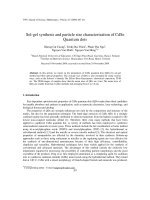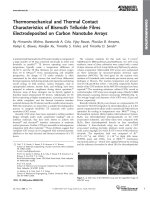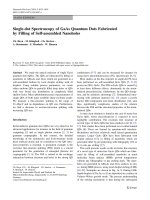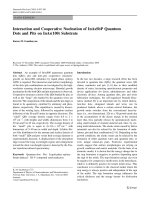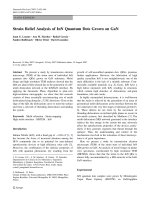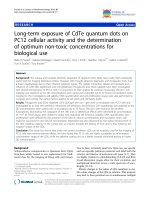Fabrication and characteristics of nanocomposite TiO2/GQDs thin films
Bạn đang xem bản rút gọn của tài liệu. Xem và tải ngay bản đầy đủ của tài liệu tại đây (786.87 KB, 9 trang )
SCIENTIFIC JOURNAL OF HANOI METROPOLITAN UNIVERSITY − VOL.62/2022
79
FABRICATION AND CHARACTERISTICS OF
NANOCOMPOSITE TiO2/GQDs THIN FILMS
Dang Tran Chien1*, Phan Xuan Thien2
1
Hanoi University of Natural Resources and Environment,
2
Institute of Material Sciences, Vietnam Academy of Science & Techonology
Abstract: This work carries out the study and fabrication of TiO2/Graphene Quantum
Dots (GQDs) nanocomposite thin films to be applicated as an electronic collection
material layer in nanostructured solar cells. The different concentrations of added GQDs
by the spreading method were loaded on TiO2/GQDs nanocomposite films. The
fabricated films were investigated for their structural and morphological characteristics
by X-ray diffraction spectroscopy; Ramam spectra and Scanning Electron Microscopy
(SEM) imaging. The optical properties were investigated through absorption and
fluorescence spectroscopy. The photoelectrical properties of the film were investigated
on measuring I-V characteristics in the dark and when illuminated by the solar simulator
AM 1.5G. The obtained results show that adding GDQs has significantly improved the
photoelectronic properties of the materials.
Keywords: TiO2, GQDs, nanostructure solar cells.
Received 3 May 2022
Revised and accepted for publication 26 July 2022
(*) Email:
1. INTRODUCTION
TiO2 is one of the promising materials for applications ranging from water spliting, solar
cells, energy storage devices, optoelectronic devices, photocatalysis. Nanostructured TiO2 films
are used as the electron-collecting material layer and plays an important role to the parameters
of the devices. However, TiO2 is a wide band gap semiconductor material so it absorbs light in
the ultraviolet region, in addition, the conductivity of TiO2 is also very low, which limits a lot
to improving the performance of solar cells as well as being less efficient when used as a
photocatalyst under sunlight. On the other hand, the high recombination rate of the carrier is
also a reason for the efficiency of solar cell devices as well as the low efficiency of
photocatalysis. To overcome those disadvantages, the adding of semiconductor quantum dots
80
HANOI METROPOLITAN UNIVERSITY
(QDs), such as CdS, CdSe, PbS, especially GQDs onto the TiO2 material films has been
proposed to expanding the working spectrum to the visible light region, increasing the ability
to separate charge carrier pairs as well as increasing the ability to conduct electrons to the
electrodes [1, 2, 3]. Among the quantum dots that are attracting researchers' attention, GQDs is
a new type of material that has been researched and fabricated recently and it has many special
physical and chemical properties such as high electrical conductivity, strong luminescence,
luminescence wavelength changes with the excitation light wavelength [4, 5], capable of
forming bonds with TiO2 crystals [1, 6]. In addition, GQDs have more advantages than
conventional semiconductor QDs that are easy to fabricate and very environmentally friendly.
Therefore, the combination of GQDs with TiO2 nanocrystals is considered to be able to give
the material system with better optical absorption, reducing the recombination process due to
the charge transfer between the nanocrystals TiO2 and GQDs, increasing the conductive
property of the material system. This promises to provide a material system with suitable
properties for making 3rd generation solar cell devices as well as increasing their photocatalytic
ability. In this work, we fabricated TiO2/GQDs nanocomposite thin film used as an electronic
collection layer in nanostructured solar cell devices. The different concentrations of added
GQDs by the spreading method were loaded on TiO2/GQDs nanocomposite films. The
fabricated films were investigated for their structural and morphological characteristics by Xray diffraction spectroscopy; Ramam spectra and SEM imaging. The optical properties were
investigated through absorption and fluorescence spectroscopy. The photoelectric properties of
the film were investigated on measuring I-V characteristics in the dark and when illuminated
by the solar simulator AM 1.5G. The obtained results show that adding GDQs has significantly
improved the photoelectronic properties of the material that can be applied to improve the
performance of nanostructured solar cell devices.
2. CONTENT
2.1. Experimental setup
The chemicals used in this work are included: ethanol C2H5OH (99.7%,), aceton CH3CHO
(99.5%), zinc powder Zn (90%), hydrochloric acid HCl (1M), decon 90 (Fisher), deionized
water, titanium dioxide (TiO2-P25), graphene quantum dots (GQDs). GQDs were chemically
prepared by initial carbon precursors trinitropyrene, sodium hydroxide with an average size of
about 2-5 nm, have absorption spectra in the range of 300 -500 nm and luminescence with
emission wavelengths from ultraviolet to 600 nm. The detail of the procedure was published in
[7, 8]. Titanium dioxide TiO2 P25 were added to ethanol, distilled water and GQDs, stirring for
15 minutes, then the mixture was ultrasonically vibrated for 30 minutes, as shown in Figure 1.
Titanium-dioxide (TiO2) nanoparticles suspension concentration in ethanol by volume was
5% then the GQDs solution were added to TiO2 solution with volume concentration at 0%, 5%,
10%, 20%, and 30%.
SCIENTIFIC JOURNAL OF HANOI METROPOLITAN UNIVERSITY − VOL.62/2022
81
Fig.1. The procedure of fabrication of TiO2/GQDs nanocomposite films
The samples fabricated for the study include: Sample 0%: TiO2 powder / ethanol and
samples of nanocomposite TiO2, GQDs/2ml ethanol in the ratios: 0.05%, 0.1%, 0.2%, 0.3% of
GQDs in terms of mass. The solution mixtures were stirred for 15 minutes and then
ultrasonically vibrated for 30 minutes so that TiO2 was uniformly distributed with GQDs in
water- ethanol medium. To investigate the photocurrent, the FTO/TiO2/GQDs samples were
fabricated as follows: Fluorine-doped Tin Oxide (FTO)/glass substrates were prepared using
HCl solutions 1M and zinc powder. Firstly, cover the FTO substrates to be retained with
vacuum tape. Secondly, a thin layer of zinc powder is evenly coated on the surface to be etched,
after 15 minutes, the FTO layer completely corroded. The FTO substrates were cut into small
pieces of the dimensions 4.5 cm x 1.5 cm and then etched as shown in Figure 2 then use
vacuum tape to cover the parts without TiO2/GQDs loaded on. The coated film is 1.5 cm x 0.5
cm in size. Drop 20 µl of TiO2/GQDs solution on the prepared substrate, then it was placed on
a ultrasonic vibrator to spread the membrane evenly. The sample was annealed at temperature
of 80°C to evaporate the solvent. Finally, the sample was annealed at 450°C for 30 minutes.
Fig. 2. Schematics of TiO2/GQDs composite films synthesis by spreading method
and the photogragh of TiO2/GQDs composite films with volume concentration of GQDs
at 0%, 5%, 10%, 20%, and 30%.
82
HANOI METROPOLITAN UNIVERSITY
2.2. Results and discussion
Figure 3 shows the SEM image of TiO2/GQDs samples spreaded on silicon substrate with
different concentrations of GQDs, annealed at 450oC for 30 minutes. As shown in Figure 3, the
fabricated TiO2/GQDs films are quite porous with 18-25 nm TiO2 particles. The images of the
GQDs can not be observed because they are so small that the SEM method can not
recognize them.
Fig.3. SEM images of TiO2/GQDs with GQDs concentrations a) 0%, b) 5%, c) 10%, d) 20%, e) 30%
Figure 4 shows the XRD spectrum of the TiO2/GQDs films after annealing. As can be seen
on the Figure, the peaks on the XRD spectrum corresponded with anatase phase TiO2 and no
strange peaks appeared. This proves that after being annealed at 450oC for 30 minutes, TiO2
films are completely become anatase phase. When adding GQDs to TiO2 material, the
diffraction peaks of TiO2 remain unchanged and strange peaks did not appear, indicating that
the addition of GQDs does not change the crystal structure of TiO2.
Fig.4. XRD diffraction patterns of TiO2/GQDs with GQDs concentrations a) 0%, b) 5%, c)
10%, d) 20%, e) 30%
In addition, it can be seen that the thin film included only pure TiO2, the TiO2 particles are
lacking in high porosity. After being mixed with GQDs (Figure 3 b, c, d, e), it seems that the
presence of GQDs enhances the binding between TiO2 and TiO2 particles, so the film has an
attachment cohesive and less porous.
SCIENTIFIC JOURNAL OF HANOI METROPOLITAN UNIVERSITY − VOL.62/2022
83
TiO2 - GQDs 5%
TiO2 - GQDs 10%
TiO2 - GQDs 20%
Intensity (counts)
104
TiO2 - GQDs 30%
TiO2
103
102
101
200
400
600
800
1000
1200
1400
1600
1800
2000
Raman shift (cm-¹)
Fig. 5. Raman spectra of TiO2/GQDs with different concentrations of GQDs
Fig. 6. Absorption spectra of TiO2/GQDs with different concentrations of GQDs
Due to the reason that the existence of GQDs in the TiO2/GQDs composite films were not
observed by SEM images and X-ray diffraction patterns, Raman spectroscopy was conducted
on the fabricated samples. The results are as shown in Figure 5.
From Figure 5, one can see that the TiO2/GQDs composite films with different
concentrations of GQDs all appear strong peaks corresponding to the number of waves at about
395 cm-1, 521 cm-1, 638 cm-1 which characterized the properties of anatase TiO2 material. In
addition, there are some peaks with much smaller intensity at the wave number position of about
1376 cm-1 and 1675 cm-1, corresponding to the vibrational mode that responsible for the D and
G bands of the quantum dot graphene material. With those results, the presence of GQDs in
the TiO2 films can be confirmed so TiO2/GQDs nanocomposite films have been successfully
fabricated.
The TiO2/GQDs films on the glass substrate were heat treated for UV-VIS absorption
spectroscopy. The results are shown in Figure 6. It can be seen that the pure TiO2 film absorbs
in the ultraviolet region, but the absorption tail extends to the region above 500 nm. This is
84
HANOI METROPOLITAN UNIVERSITY
because the TiO2 material has a high porosity, which causes light to be scattered strongly, so
the transmittance of the film is reduced. With adding GQDs, the absorption intensity of
TiO2/GQD films at wavelength below 500 nm was significantly enhanced, especially in the
ultraviolet range from 350 to 400 nm. TiO2/GDQs samples with 5% and 10% GQDs
concentration showed the strongest absorption. This is consistent with the fact that both TiO2
and GQDs materials strongly absorb in the UV region. In addition, GQDs also partially absorb
light in the 500 nm region. Above 500 nm of wavelength, the films containing GQDs have
reduced absorption intensity compared to the TiO2 sample. This is because the overlap of GQDs
between TiO2 nanoparticles increases the bonding ability between the materials. Therefore, the
film is not too porous like pure TiO2 film, thus reducing the scattering phenomenon in the film.
This is consistent with the results of SEM image studied as presented in the previous section.
The optical properties of TiO2/GQDs nanocomposites are also studied through fluorescence
spectrometry. Figures 7a and 7b are the fluorescence spectra of TiO2/GQDs film samples with
different concentrations excited by lasers with wavelengths of 325 nm and 420 nm,
respectively. In the case of excitation at 325 nm (Figure 7a), the emission peak is observed at
about 400 nm with weak intensity in all samples. Those peaks are related to a direct transition
(band - band). A strong spectral band at longer wavelengths from about 450 nm to 750 nm
occurs both in pure TiO2 and GQDs-doped films. The strong luminescence of TiO2 films in the
visible light is thought to be emission processes from surface states due to oxygen vacancies
and defects on TiO2. This result coincides with the results of Yu Chen et al. [9] and many other
studies on TiO2 nanomaterials. When adding GQDs to the TiO2 film, the luminescence intensity
of the samples corresponding to the band-band emissions and the emission due to the surface
state increased significantly compared to the pure TiO2 film and the spectral form was
completely unchanged.
Fig.7. Photoluminenscence spectra of TiO2/GQDs with different concentrations of GQDs: a)
325 nm and b) 420 nm excited wavelengths
This phenomenon can be explained as follows: The electrons of GQDs, after being excited
to the conduction band, have shifted to the conduction band of TiO2 due to the difference in
energy levels of the two materials. The electron then recombines with the hole in the valence
band of TiO2 leading to emitting luminescence. From Figure 7, it can be seen that when the
SCIENTIFIC JOURNAL OF HANOI METROPOLITAN UNIVERSITY − VOL.62/2022
85
GQDs concentration changes, the photoluminescence (PL) spectrum also changes but not much
and the sample with 20% GDQs gives the highest intensity of PL spectral peaks.
With excitation wave at 420 nm which has a lower energy than the band gap of TiO2 so
there is a indirect transition band to band in the material system. Luminescence emitting due to
surface states at wavelengths in the range 470 nm to 750 nm. When the concentration of GQDs
increased, the intensity of the PL spectrum increased and reached the maximum in the sample
with 10% GQDs, then began to decrease gradually. These results indicate that the
nanopcomposite TiO2/GQDs films have a charge transfer between GQD and TiO2 and the
transfer depends not too much on the content of GQDs particles.
Fig. 8. I-V characteristic curve of TiO2/GQDs in dark and under ullimination
To investigate the photoelectrical properties of the TiO2/GQDs films, I-V measurement
under illumination and in dark was conducted. The measured potential ranges linearly from 1V to 1V. The results are as shown in Figure 7 and Table 1. It can be seen that when illuminated,
the photocurrent intensity of all TiO2 films with GQDs increases and has a larger value than
that of TiO2 films without GQDs. This proves that the nanocomposite films exhibits better
photoelectric properties than pure TiO2 films. The highest current is 10% TiO2/GQDs sample.
This is completely consistent with the results of fluorescence spectroscopy studies of the
materials. 10% samples with 10 % GQDs show better charge transfer and has maximum PL
spectral intensity.
86
HANOI METROPOLITAN UNIVERSITY
Table 1. Curent and resistance of the TiO2/GQDs films at a potential of 1V
The resistance of the films without illumination is smaller than that of the TiO2 films,
indicating that GQDs reduce the resistance of the TiO2 films and increase the photoelectric
properties of the films. These results are shown in Table 1 in which one can see the 10% sample
gives the largest change rate and reaches a value of 3.29 times. Moreover, the resistance of
TiO2/GQDs films is also significantly smaller than that of pure TiO2 film. This result shows
that TiO2/GQDs can improve the performance of solar cells.
3. CONCLUSION
TiO2/GQDs nanocomposite films have been successfully fabricated by spreading method
with different GQDs concentrations from 0 to 30% by volume. TiO2/GQDs films increase the
light absorption capacity of materials in the ultraviolet region. The good charge transfer process
between GQDs and TiO2 contributes to increasing charge separation of the material system.
The sample with 10% GQDs reaches a value of 3.29 times, the resistance of TiO2/GQDs films
is also significantly smaller than that of pure TiO2 film. With properties such as strong light
absorption (especially in the ultraviolet) and high electrical conductivity, GQDs can overcome
the disadvantages of TiO2 material. Nanocomposites TiO2/GQDs layers can be used as electron
collectors for nanostructured solar cells with high efficiency.
Acknowledgement
This work has been done at the Lab of Material & Energy Devices, Institute of Material
Sciences, Vietnam Academy of Science & Techonology, 18 Hoang Quoc Viet Str., Cau Giay
Dist., Hanoi under the supervision of Associate Professor Pham Duy Long.
SCIENTIFIC JOURNAL OF HANOI METROPOLITAN UNIVERSITY − VOL.62/2022
87
REFERENCES
1. P. Sudhagar , I. H. Cardona , H. Park , T. Song , S. H. Noh , S. Gimenez, I. M. Sero , F. F. Santiago, J.
Bisquert, C. Terashimae, U. Paik, Y. S. Kang, A.Fujishimae, T.H. Han (2016), “Exploring Graphene
Quantum Dots/TiO2 interface in photoelectrochemical reactions: Solar to fuel conversion”,
Electrochimica Acta, vol. 187: pp. 249-255.
2. G. Rajende, J. Kumar, P.K. Giri (2018), “Interfacial charge transfer in oxygen deficient TiO2-graphene
quantum dot hybrid and its influence on the enhanced visible light photocatalysis”, Applied Catalysis
B: Environmental, vol. 224: pp. 960-972.
3. H. Wang, P. Sun, S. Cong, J. Wu, L. Gao, Y. Wang, X. Dai, Q.Yi, G. Zou (2016), “ Nitrogen-Doped
Carbon Dots for “ green ” Quantum Dot Solar Cells”, Nanoscale Research Letters, vol 11: pp.27.
4. S.Zhu, Y. Song, X. Zhao, J. Shao, J. Zhang, B. Yang (2015), “The photoluminescence mechanism
in carbon dots (graphene quantum dots, carbon nanodots, and polymer dots): Current state and future
perspective”, Nano Research, vol. 8(2): pp. 355–381.
5. B. Zheng, Y. Chen, P. Li, Z. Wang, B. Cao, F. Qi, J. Liu, Z. Qiu, W. Zhang (2017), “Ultrafast
ammonia-driven, microwave-assisted synthesis of nitrogen-doped graphene quantum dots and their
optical properties”, Nanophotonics, vol. 6(1): pp. 259–267.
6. Y. Zhang, N. Zhang, Z. R. Tang, Y.J. Xu (2012), “Improving the photocatalytic performance of
graphene–TiO2 nanocomposites via a combined strategy of decreasing defects of graphene and
increasing interfacial contact”, Physical Chemistry Chemical Physics, vol. 14: pp.9167-9175.
7. P.N. Thang, L.X. Hung, V. D. Chinh, P. N. Hong, D. N. Tu, P. T. Nga (2018) “Plasmon effect of
graphene quantum dots on corrugated silver film”, Electric Electron Tech Open Acc. J , vol. 2(6):
pp.367‒370.
8. S. Yu, Y. Zhong, B. Yu, S. Cai, L. Wu, Y. Zhou (2016) “Graphene quantum dots to enhance the
photocatalytic hydrogen evolution efficiency of anatase TiO2 with exposed {001} facet”, Physical
Chemistry Chemical Physics, vol. 18: pp. 20338-20344.
9. Xuqiang Hao, Zhiliang Jin, JingXua Shixiong Min, Gongxuan Lu (2016), “Functionalization of
TiO2 with graphene quantum dots for efficient photocatalytic hydrogen evolution”, Superlattices and
Microstructures, vol.94: pp.237-244.
CHẾ TẠO VÀ KHẢO SÁT CÁC TÍNH CHẤT ĐẶC TRƯNG
CỦA MÀNG MỎNG NANOCOMPOZIT TiO2/GQDs
Tóm tắt: Trong bài báo này chúng tơi nghiên cứu và chế tạo màng mỏng na nô compozit
TiO2/GQDs (Chấm lượng tử Graphene) ứng dụng làm lớp vật liệu thu điện tử trong pin mặt
trời cấu trúc nano. Nồng độ khác nhau của GQDs được phủ bằng phương pháp trải trên màng
mỏng na nô compozit TiO2/GQDs. Đặc điểm cấu trúc và hình thái của các màng mỏng na nơ
compozit TiO2/GQDs được khảo sát bằng phương pháp nhiễu xạ tia X, phổ Ramam và chụp ảnh
SEM. Tính chất quang học được khảo sát bằng phương pháp đo phổ hấp thụ và phổ huỳnh
quang. Tính chất quang điện của màng mỏng được nghiên cứu thơng qua đo đặc trưng I-V trong
bóng tối và khi được chiếu sáng bởi đèn mô phỏng ánh sáng Mặt trời AM 1.5G. Kết quả thu
được cho thấy việc bổ sung GDQs đã cải thiện đáng kể các đặc tính quang điện tử của vật liệu.
Từ khóa: Ôxít Titan (TiO2), Chấm lượng tử Graphene (GQDs); Pin mặt trời cấu trúc nano.
